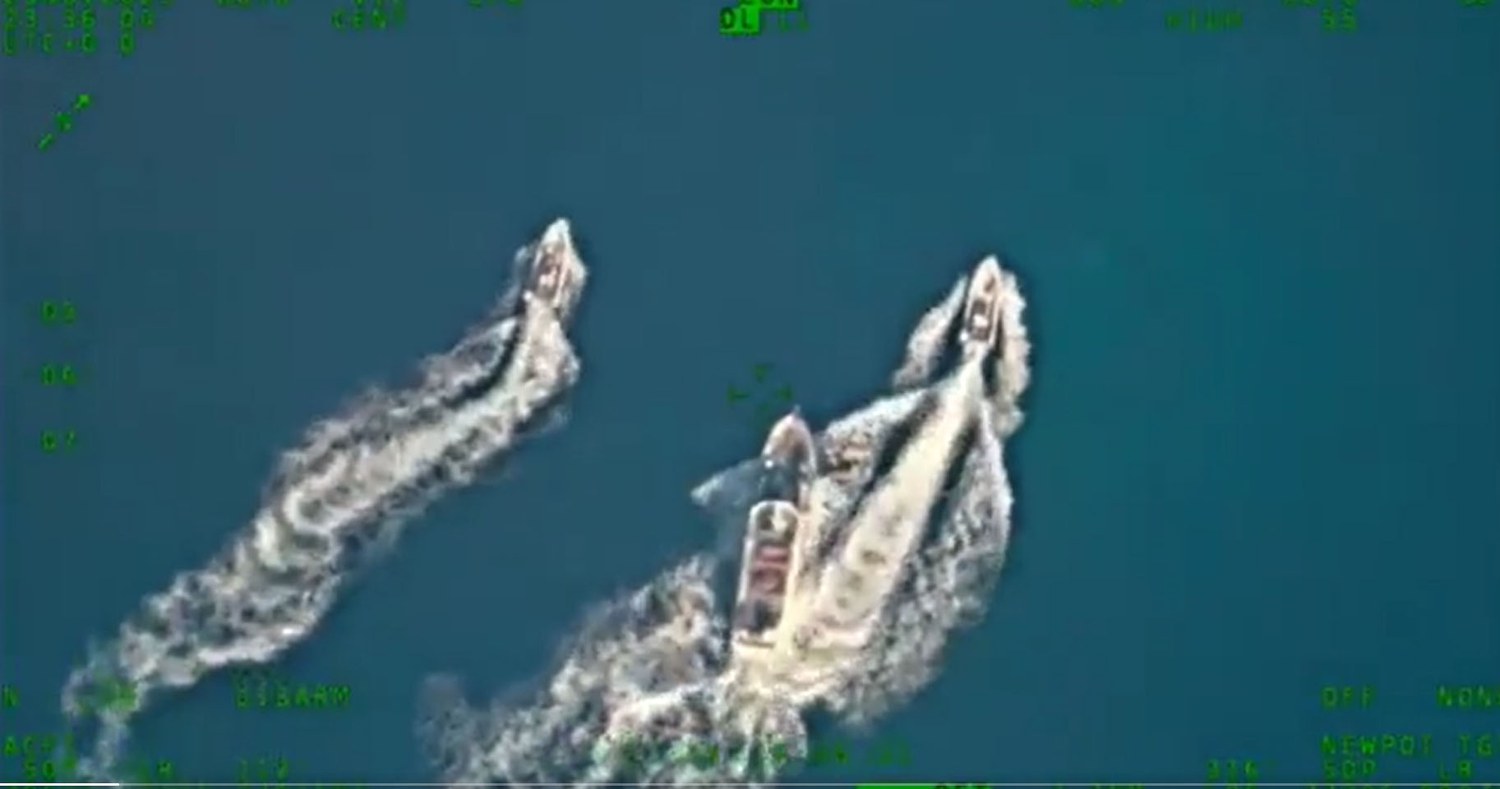China
Beijing tests Manila’s nerves in disputed reef

China was once again trying to block Philippine ships from delivering supplies to the troops stationed at the Second Thomas Shoal in the South China Sea on Friday.
Earlier in the day, “China Coast Guard (CCG) and Chinese Maritime Militia (CMM) vessels recklessly harassed, blocked, executed dangerous maneuvers in another attempt to illegally impede or obstruct a routine resupply and rotation mission to BRP Sierra Madre (LS 57) at Ayungin Shoal (Second Thomas Shoal),” the National Task Force for the West Philippine Sea said in a statement. The West Philippine Sea is the name that Filipinos use for waters claimed by Manila in the South China Sea.
“CCG vessel 5203 deployed water cannon against Philippine supply vessel M/L Kalayaan,” it said. M/L, or motor launch, implies a small-sized, motor-powered boat.
The Kalayaan and another supply boat, the Unaizah Mae 1, were “also subjected to extremely reckless and dangerous harassment at close proximity” by Chinese vessels inside the shoal’s lagoon during their approach to BRP Sierra Madre, said the Philippine National Task Force.
“Nonetheless, both supply boats were able to successfully reach LS 57 (BRP Sierra Madre),” it said.
“We condemn, once again, China’s latest unprovoked acts of coercion and dangerous maneuvers … that has put the lives of our people at risk.”
Manila deliberately ran the World War II-era Sierra Madre aground in 1999 to serve as its outpost at the shoal and has to dispatch ships on a regular basis to deliver fresh supplies to the military personnel there.
The Philippines’ rotation and resupply (RoRe) missions have recently been increasingly impeded and blocked by Chinese ships.
In a graphic provided by Ray Powell from the U.S. Gordian Knot Center for National Security Innovation, Philippine Coast Guard ships accompanying the two supply boats were surrounded by a large number of Chinese vessels.
“In total, 24 Chinese ships were involved in the incident, including four Coast Guard ships. The rest were maritime militia ships,” Powell said.
Continuing blockade
“Beijing is testing Manila’s nerves,” said Malcolm Davis, a defense analyst at the Australian Strategic Policy Institute (ASPI).
“China will keep on conducting such blockades with the hope that Manila will give up its RoRe missions but it won’t happen,” Davis told Radio Free Asia.
When and how the United States, the Philippines’ treaty ally, will get involved remains to be seen, according to the analyst. By a mutual defense treaty, Washington is obliged to defend its ally in the case the latter is being attacked.
The U.S. has repeatedly said that Article IV of the 1951 U.S.-Philippines Mutual Defense Treaty “extends to armed attacks on Philippine armed forces, public vessels, and aircraft – including those of its Coast Guard – anywhere in the South China Sea.”
The Chinese Coast Guard quickly issued a statement calling Manila’s mission “illegal.”
Spokesperson Gan Yu said that “two small transport ships and three coast guard ships from the Philippines entered the waters adjacent to Ren’ai Reef (Chinese name for Second Thomas Shoal) in China’s Nansha (Spratly) Islands without permission from the Chinese government.”
“The Chinese Coast Guard follows Philippine ships in accordance with the law, takes control measures, and makes temporary special arrangements for the Philippines to transport food and other necessary daily supplies,” Gan said.
“The Philippines’ actions violate China’s territorial sovereignty, violate the Declaration on the Conduct of Parties in the South China Sea, and violate its own commitments,” he said, “We urge the Philippines to immediately stop its infringing actions.”
For its part, Manila said the Philippine Embassy in China “has demarched the Chinese foreign ministry and protested” against China’s actions.
As of Nov. 7, the Philippines has made 58 diplomatic protests against what it sees as China’s violations of its sovereignty in the South China Sea.
Last month Manila summoned the Chinese ambassador to the Philippines to protest over two similar incidents, one of which led to a small collision of ships.
Second Thomas Shoal is about 200 kilometers (124 miles) from the Philippine island of Palawan, and more than 1,000 kilometers from China’s Hainan island. It is claimed by the Philippines, China, Vietnam and Taiwan, but is located inside the Philippines’ exclusive economic zone (EEZ).
Edited by Mike Firn and Elaine Chan.
BenarNews is an RFA-affiliated online news organization.
Read the rest of this article here >>> Beijing tests Manila’s nerves in disputed reef
China
China Unveils Measures to Enhance Hotel Accommodation for Foreign Workers

China’s new measures aim to simplify hotel accommodations for overseas travelers by removing qualification barriers and improving service standards, payment convenience, and registration processes. This addresses challenges faced by foreign guests and supports China’s goals of high-level openness and inbound tourism growth, following complaints from foreign travelers.
China introduced new measures aiming to simplify hotel accommodations for overseas travelers by removing qualification barriers and enhancing service standards, payment convenience, and registration processes. These changes address previous challenges faced by foreign guests and support China’s broader goals of high-level openness and inbound tourism growth.
On July 25, 2024, the Ministry of Commerce (MOFCOM) and six other departments jointly issued the Notice on Several Measures to Facilitate Accommodation for Overseas Personnel in High-Level Service and Opening Up (The Notice), to address the difficulties faced by inbound overseas travelers regarding hotel accommodation.
This follows up on several foreign travelers from Nigeria and the United Kingdom who left messages on the Chinese government website, reflecting that they were refused when attempting to check in at hotels in China.
To solve the issues flagged by overseas travelers, the Notice proposed accommodation facilitation measures in the following eight aspects: operating in compliance with the law, enhancing reception capacity, strengthening industry self-discipline, leveraging platform roles, optimizing registration management, ensuring smooth service channels, improving payment convenience, and fostering a friendly atmosphere.
We summarize the details of the proposed measures below:
Foreign travelers often encounter difficulties when attempting to check into hotels in China. Reasons for hotel refusals include not having the necessary qualifications for foreign guests or not knowing how to input information into the system.
In China, there used to be a rule that only foreign-related hotels, or “涉外酒店” (shè wài jiǔdiàn) can accommodate foreigners. Such hotels refers to accommodation facilities such as hotels, guesthouses, apartments, and resorts that have been approved by various levels of business administration and public security departments to accommodate foreigners, overseas Chinese, Hong Kong and Macau compatriots, and Taiwanese.
This article is republished from China Briefing. Read the rest of the original article.
China Briefing is written and produced by Dezan Shira & Associates. The practice assists foreign investors into China and has done since 1992 through offices in Beijing, Tianjin, Dalian, Qingdao, Shanghai, Hangzhou, Ningbo, Suzhou, Guangzhou, Dongguan, Zhongshan, Shenzhen, and Hong Kong. Please contact the firm for assistance in China at china@dezshira.com.
China
China Provides Tax Incentives on Special Equipment for Green and Digital Development

China has introduced a new tax incentive for companies investing in digital and smart upgrades of special equipment to encourage environmental protection and safe production. Companies can enjoy a 10 percent deduction from their corporate income tax payable. Eligibility and requirements are outlined by the Ministry of Finance and State Tax Administration.
A new China tax incentive aims to encourage companies to invest in digital and smart upgrades of special equipment. Companies upgrading certain equipment that aids environmental protection and safe production can enjoy a deduction of the investment at a rate of 10 percent from their corporate income tax payable. We explain the requirements of the new tax incentive.
China’s Ministry of Finance (MOF) and State Tax Administration (STA) have issued a new preferential corporate income tax (CIT) incentive for companies investing in digital and intelligent transformations of certain types of equipment. To be eligible for the incentive, companies must invest in the digital and intelligent transformation of equipment related to energy and water conservation, environmental protection, and safe production.
The new tax incentive aligns with a State Council Action Plan, released in March 2024, which aims to accelerate the renewal of large-scale equipment and consumer goods, promoting high-quality development and driving investment and consumption for long-term benefits.
If the annual CIT payable is insufficient for the offset, it can be carried forward to future years for up to five years.
The CIT payable refers to the balance after multiplying the annual taxable income by the applicable tax rate and deducting the tax reductions and exemptions according to China’s CIT Law and relevant preferential policies.
Note that companies enjoying the tax incentives must use the transformed equipment themselves. If the equipment is transferred or leased within five tax years after the transformation is completed, the incentives must stop from the month the equipment is no longer in use, and the previously offset CIT must be repaid.
The “special equipment” eligible for the preferential tax treatment covers equipment purchased and used by companies listed in the Catalog of Special Equipment for Safe Production for Corporate Income Tax Incentives (2018 Edition) and the Catalog of Special Equipment for Energy Saving, Water Conservation, and Environmental Protection for Corporate Income Tax Incentives (2017 Edition).
This article is republished from China Briefing. Read the rest of the original article.
China Briefing is written and produced by Dezan Shira & Associates. The practice assists foreign investors into China and has done since 1992 through offices in Beijing, Tianjin, Dalian, Qingdao, Shanghai, Hangzhou, Ningbo, Suzhou, Guangzhou, Dongguan, Zhongshan, Shenzhen, and Hong Kong. Please contact the firm for assistance in China at china@dezshira.com.
China
Revealing the Encouraged Industries of Hainan in 2024: Unlocking Opportunities

The 2024 Hainan Encouraged Catalogue, issued by the NDRC, MOF, and STA, aims to boost industries in the Hainan Free Trade Port. It prioritizes sectors like tourism, modern services, and high technologies, offering incentives for foreign investment and market access expansion since 2020. The Catalogue includes 176 entries across 14 categories, with 33 new additions focusing on cultural tourism, new energy, medicine and health, aviation, aerospace, and environmental protection.
The National Development and Reform Commission (NDRC), in collaboration with the Ministry of Finance (MOF) and the State Taxation Administration (STA), has issued the Catalogue of Industries Encouraged to Develop in Hainan Free Trade Port (2024 Version), hereinafter referred to as the “2024 Hainan Encouraged Catalogue.” The updated Catalogue took effect on March 1, 2024, replacing the previous 2020 Edition.
Beyond the industries already addressed in existing national catalogues, the new entries in the 2024 Hainan Encouraged Catalogue are based on practical implementation experiences and the specific needs within Hainan, prioritizing sectors such as tourism, modern services, and high technologies.
The Hainan FTP has been providing incentives to draw investors to invest and establish businesses in the region, especially foreign investment. Alongside a phased approach to opening the capital account and facilitating free capital movement, Hainan has significantly expanded market access for foreign enterprises since 2020, particularly in sectors such as telecommunications, tourism, and education.
The Hainan Encouraged Catalogue comprises two main sections:
Similar to the approach adopted by the western regions, foreign-invested enterprises (FIEs) should always implement their production or operations in accordance with the Catalogue of Encouraged Industries for Foreign Investment.
On top of the industries already addressed in existing national catalogues, the 2024 Hainan Encouraged Catalogue encompasses 14 distinct categories and a total of 176 entries especially encouraged in the region, including 33 new additions compared to the 2020 Edition. These new entries predominantly span cultural tourism, new energy, medicine and health, aviation and aerospace, and ecological and environmental protection, among others.
This article is republished from China Briefing. Read the rest of the original article.
China Briefing is written and produced by Dezan Shira & Associates. The practice assists foreign investors into China and has done since 1992 through offices in Beijing, Tianjin, Dalian, Qingdao, Shanghai, Hangzhou, Ningbo, Suzhou, Guangzhou, Dongguan, Zhongshan, Shenzhen, and Hong Kong. Please contact the firm for assistance in China at china@dezshira.com.






